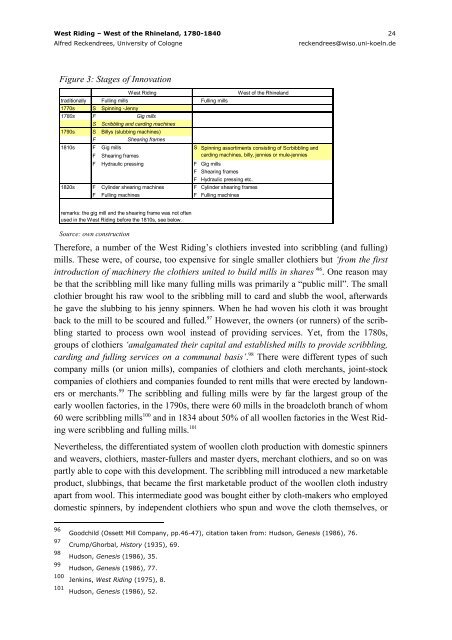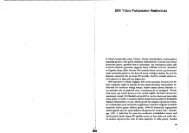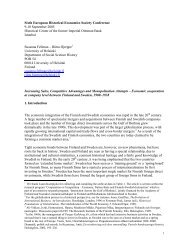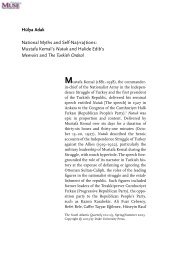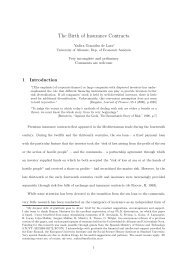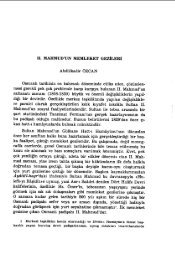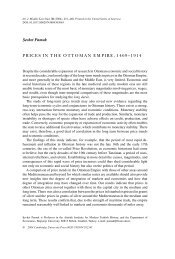West Riding – Western Rhineprovince, 1790-1840: Diverse Paths to ...
West Riding – Western Rhineprovince, 1790-1840: Diverse Paths to ...
West Riding – Western Rhineprovince, 1790-1840: Diverse Paths to ...
Create successful ePaper yourself
Turn your PDF publications into a flip-book with our unique Google optimized e-Paper software.
<strong>West</strong> <strong>Riding</strong> <strong>–</strong> <strong>West</strong> of the Rhineland, 1780-<strong>1840</strong> 24<br />
Alfred Reckendrees, University of Cologne reckendrees@wiso.uni-koeln.de<br />
Figure 3: Stages of Innovation<br />
traditionally Fulling mills Fulling mills<br />
1770s S Spinning -Jenny<br />
1780s F Gig mills<br />
S Scribbling and carding machines<br />
<strong>1790</strong>s S Billys (slubbing machines)<br />
F Shearing frames<br />
1810s F Gig mills S<br />
F Shearing frames<br />
<strong>West</strong> <strong>Riding</strong> <strong>West</strong> of the Rhineland<br />
F Hydraulic pressing F Gig mills<br />
F Shearing frames<br />
F Hydraulic pressing etc.<br />
1820s F Cylinder shearing machines F Cylinder shearing frames<br />
F Fulling machines F Fulling machines<br />
remarks: the gig mill and the shearing frame was not often<br />
used in the <strong>West</strong> <strong>Riding</strong> before the 1810s, see below.<br />
Source: own construction<br />
Spinning assortiments consisting of Scrbibbling and<br />
carding machines, billy, jennies or mule-jennies<br />
Therefore, a number of the <strong>West</strong> <strong>Riding</strong>’s clothiers invested in<strong>to</strong> scribbling (and fulling)<br />
mills. These were, of course, <strong>to</strong>o expensive for single smaller clothiers but ‘from the first<br />
introduction of machinery the clothiers united <strong>to</strong> build mills in shares’ 96 . One reason may<br />
be that the scribbling mill like many fulling mills was primarily a “public mill”. The small<br />
clothier brought his raw wool <strong>to</strong> the sribbling mill <strong>to</strong> card and slubb the wool, afterwards<br />
he gave the slubbing <strong>to</strong> his jenny spinners. When he had woven his cloth it was brought<br />
back <strong>to</strong> the mill <strong>to</strong> be scoured and fulled. 97 However, the owners (or runners) of the scribbling<br />
started <strong>to</strong> process own wool instead of providing services. Yet, from the 1780s,<br />
groups of clothiers ‘amalgamated their capital and established mills <strong>to</strong> provide scribbling,<br />
carding and fulling services on a communal basis’. 98 There were different types of such<br />
company mills (or union mills), companies of clothiers and cloth merchants, joint-s<strong>to</strong>ck<br />
companies of clothiers and companies founded <strong>to</strong> rent mills that were erected by landowners<br />
or merchants. 99 The scribbling and fulling mills were by far the largest group of the<br />
early woollen fac<strong>to</strong>ries, in the <strong>1790</strong>s, there were 60 mills in the broadcloth branch of whom<br />
60 were scribbling mills 100 and in 1834 about 50% of all woollen fac<strong>to</strong>ries in the <strong>West</strong> <strong>Riding</strong><br />
were scribbling and fulling mills. 101<br />
Nevertheless, the differentiated system of woollen cloth production with domestic spinners<br />
and weavers, clothiers, master-fullers and master dyers, merchant clothiers, and so on was<br />
partly able <strong>to</strong> cope with this development. The scribbling mill introduced a new marketable<br />
product, slubbings, that became the first marketable product of the woollen cloth industry<br />
apart from wool. This intermediate good was bought either by cloth-makers who employed<br />
domestic spinners, by independent clothiers who spun and wove the cloth themselves, or<br />
96 Goodchild (Ossett Mill Company, pp.46-47), citation taken from: Hudson, Genesis (1986), 76.<br />
97 Crump/Ghorbal, His<strong>to</strong>ry (1935), 69.<br />
98 Hudson, Genesis (1986), 35.<br />
99 Hudson, Genesis (1986), 77.<br />
100 Jenkins, <strong>West</strong> <strong>Riding</strong> (1975), 8.<br />
101 Hudson, Genesis (1986), 52.


